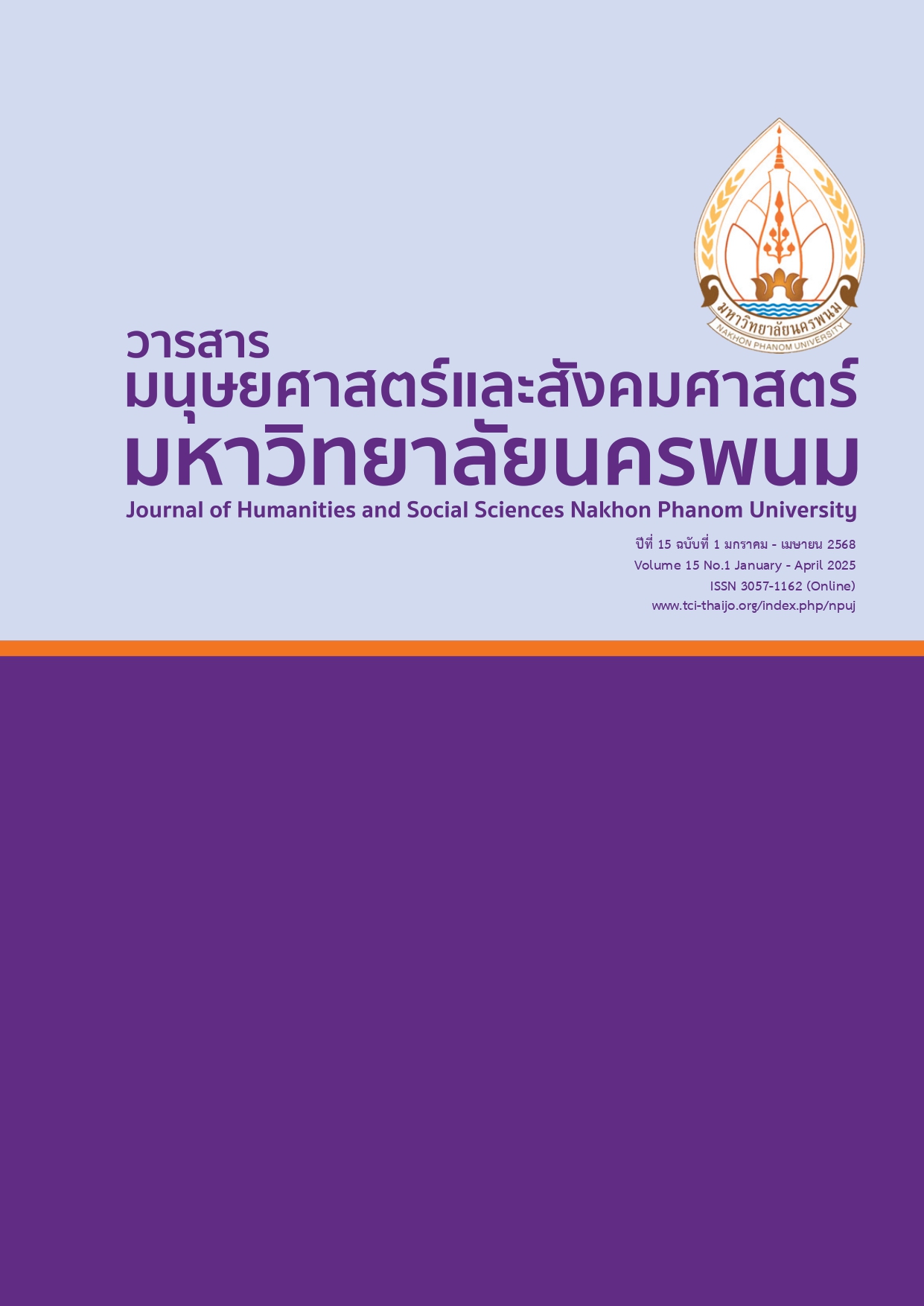The Effects of Learning Management Through Design Thinking Process in Creating Localized English Language Teaching Innovation of Pre-service Teachers
Main Article Content
Abstract
The purposes of this research were to compare the pre-service teachers’ ability score in creating localized English language teaching innovation before and after using learning management through design thinking process, and to evaluate the pre-service teachers’ competence in creating localized English language teaching innovation. The sample consisted of 18 third-year English major students from the faculty of Education and Human Development who were studying in the first semester of the academic year 2024 using sample random sampling. The experiment was carried out for 14 weeks, 3 hours each, 42 hours in total. The research instruments employed in this research were 1) 14 lesson plans using learning management through Design Thinking process, 2) a localized English language teaching innovative creation test, and 3) an evaluation form to evaluate the ability in creating localized English language teaching innovation. The data was analyzed using mean, standard deviation and the paired samples t-test. The results of the study were: 1) The pre-service teachers’ ability score in creating localized English language teaching innovation after the instruction by using the learning management through design thinking process was significantly higher than the ability before learning at the .05 level. 2) The pre-service teachers’ competence in creating localized English language teaching innovation was at a high level ( = 4.02, S.D. = 0.86). The learning management through design thinking process significantly improved pre-service teachers in creating localized English language teaching innovation abilities and the pre-service teachers’ competence in creating localized English language teaching innovation as a high level.
Article Details

This work is licensed under a Creative Commons Attribution-NonCommercial-NoDerivatives 4.0 International License.
References
Bender-Salazar, R. (2023). Design thinking as an effective method for problem-setting and needfinding for entrepreneurial teams addressing wicked problems. Journal of Innovation and Entrepreneurship, 12(1), 1-23. https://www.innovationentrepreneurship.springeropen.com/articles/10.1186/s13731-023-00291-2
Brown, T. (2009). Change by Design: How Design Thinking Transforms Organizations and Inspires Innovation. HarperCollins, New York.
Bucha, S. (2020). The Develop Learning Activities by Design Thinking with Participatory Learning to Promote Creativity of Mathayomsuksa 5 students. Journal of MCU Nakhondhat, 7(12), 210-221. https://so03. tci-thaijo.org/ index.php/ JMND/article/view/249108
Chalermsuk, N. (2023). The Development of Blended Instructional Model in Art Education Based on Design Thinking and Practical Art Learning Integrated with Cognitive Tools to Enhance Creative Thinking and Artworks of High School Students. Journal of Education Naresuan University, 25(3), 117-128. https:// www. so06.tci thaijo.org/ index.php/ edujournal_nu/article/view/246753
Clifford, J. & Reisinger, D. (2019). Community-based language learning. Georgetown University Press.
Cross, N, (2011). Design thinking: Understanding how designers think and work. Berg.
Darasawang, P., Reinders, H. & Waters, A. (2015). Innovation in language learning and teaching: The Case in Thailand. Palgrave Macmillan.
Dulyakasem, U. (2004). Thai social strategy in developing a learning method. The Teachers Council of Thailand.
Inthapthim, D., Paicharoen, N., Sathientharadol, P., Chetsadanuwat, K., & Gunma, N. (2024). The Effect of Implementation of Linguistic-Integrated Innovation for Teaching English to Minimize educational inequality of ethnic students in Phayao province. Trends of Humanities and Social Sciences Research, 12(1), 129-155.
https://www.so03.tci-thaijo.org/index.php/Humanties-up/article/view/ 272455
Kolb, D. A. (1984). Experiential Learning: Experience as the Source of Learning and Development. Prentice Hall.
Khaleddin, I. S. (2024). Innovations In Englis Language Teaching as an Important Factor of Modernization and Important. International Journal of Innovative Technologies in Social Science, 2(42), 1-3. https:// doi.org/10.31435/ rsglobal_ijitss/30062024/8143
Khammanee, T. (2013). The science of teaching. Chulalongkorn University Printing House.
Kirkland, K. & Sutch, D. (2009). Overcoming the barriers to educational innovation. Futurelab.
Henning, G. (1987). A Guide to Language Testing. Newbury House.
Hoysang, S. (2021). Developing a Social Contribution-Based Learning Model with Design Thinking to Enhance Public Mind for Dual Vocational Education Students. Journal of Education, Prince of Songkla University, Pattani Campus, 32(1), 216-230. https://so02.tci-thaijo.org/index.php/edupsu/article/download/240550/ 168085
Nilpan, M. (2015). Educational research methods. Faculty of Education, Silpakorn University.
Office of The Educational Council. (2017). Thailand education scheme (2017-2036). Retrieved April 2023, from https://www.search-library.parliament.go.th/bib/95431.
O’Sullivan, D. & Dooley, L. (2009). Applying innovation. Sage.
Pittayasenee, M. & Yuangsroi, P. (2021). Design thinking: A New Way Innovator. Lampang Rajabhat University Journal, 10(2), 190-199. https://so04.tci-thaijo.org/index.php/JLPRU/article/view/246560
Panich, V. (2014). Embedded formative assessment. Parbpim Ltd.
Rogers, E. (2003). Diffusion of Innovations (5th ed.). Free Press.
Roi Et Rajabhat University. (2024). Roi Et Rajabhat University strategic Plan 2023-2027. Retrieved December 2024, from https://www.reru.ac.th/other/19109/


